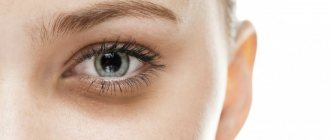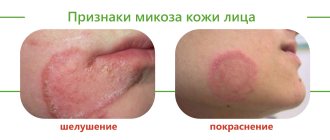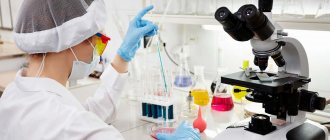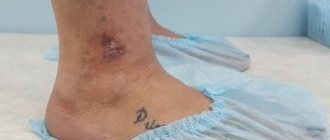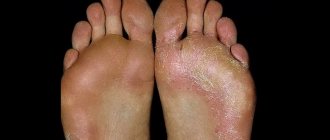Causes of fungus
Not everyone gets sick with deep mycoses. The body of healthy people successfully resists these infections. People with reduced immunity and those suffering from chronic diseases are most susceptible to deep mycoses, for example, bronchial asthma, chronic bronchitis, diabetes mellitus, and inflammatory diseases of the genital organs. Sometimes people who have undergone major operations become infected, because their body’s resistance is sharply reduced. Mycoses can also develop during long-term use of antibiotics.
Tests for skin fungus
Fungal skin diseases (dermatomycosis) are the most common among skin diseases. Fungi have been known since ancient times; they are a special type of microorganisms that combine features of both plants and animals, and fungi feed on organic substances. They are tenacious, capable of forming spores and persisting in the environment for a long time, and grow very slowly. Therefore, fungal diseases can occur without manifestations for a long time, and their detection is not an easy task for doctors.
Mostly dermatophyte fungi are causative agents of superficial fungal diseases, in particular such as microsporia, trichophytosis (ringworm), epidermophytosis. They constantly live on the skin and hair of humans and animals, some in the soil. Human contact with fungi occurs. However, the skin is normally a powerful protective barrier and does not allow fungi to exhibit pathogenic properties.
The following factors contribute to the development of fungal skin diseases:
- mechanical damage to the protective barrier of the skin: cracks, microtraumas, including those resulting from cosmetic procedures.
- failure to comply with the rules of personal hygiene at home and when visiting public saunas and baths, fitness rooms, if individual towels, slippers, and hats are not used.
These factors are not leading; the skin will not allow the enemy to penetrate if the immune system works well. A decrease in local and general immunity of the body is a decisive trigger. This is facilitated by:
- Genetic causes (congenital immunodeficiencies)
- Lack of vitamins and microelements
- Chronic skin diseases
- Endocrine diseases: diabetes mellitus primarily, thyroid dysfunction, obesity, other hormonal problems
- Long-standing chronic diseases (gastrointestinal tract, lungs, heart; tuberculosis, AIDS)
- Long-term use of antibiotics, glucocorticoids, antitumor drugs.
If the fungus has overcome all the obstacles in its path, a disease develops. The peculiarity of skin fungi is damage to the stratum corneum (surface) layer. Fungi feed on the keratin that is part of it. Skin, nails and hair are affected.
How do fungal skin diseases manifest?
Since only the superficial layers of the skin are involved, manifestations may include:
- Itching and peeling skin without spots
- The formation of red spots with clear edges in the form of one or multiple foci, usually accompanied by peeling and itching
- Nails become thicker, deformed, and split
- Hair loss due to trichophytosis
- Inflammation of hair follicles with crusting and flaking
Manifestations are typical for many skin diseases. The examination data does not allow us to determine whether there is a fungal infection of the skin or not.
To establish a diagnosis, the following laboratory methods are used:
Microscopic examination of skin, nail plates and hair for the presence of pathogenic fungi (performing time 2 days)
An important point for the correctness of the study is to take material at the border of healthy and affected tissues, where there is a higher probability of detecting active growth of fungi. The microscopic method allows you to see a pathological fungus under a microscope or exclude its presence, but does not allow you to determine the type of pathogen. Identification of fungal mycelium is a criterion for confirming active mycosis. The presence of only spores requires detailed study and confirmation by other methods.
Culture for fungi (causative agents of mycoses) (up to 30 days) is a more accurate study. Skin scrapings, nails and hair are placed in special media enriched with nutrients specifically for skin fungi. The doctor observes the growth of fungi for up to a month, since they grow very slowly and it is this period that allows an adequate examination and not to miss the disease. Thanks to culture, the specific type of dermatophyte fungus is determined, which makes it possible to prescribe the correct antifungal drug.
Please note that the malasezia furfur fungus, the causative agent of dandruff in animals and humans, does not grow in crops. This is his peculiarity!
In case of fungal diseases, determination of sensitivity to antifungal drugs is carried out only for scientific purposes in order to introduce a new medicine, since this is a long, labor-intensive process and it is impractical in medical practice. The fact is that known antifungal drugs act on certain types of fungi, and when a fungal disease is confirmed, the doctor will not wait for further progression of the process for another month, but will prescribe a drug depending on the type of fungus determined as a result of the analysis.
How to properly prepare for research?
Skin scrapings are performed only by a doctor. Hair and nails can be collected independently and placed in a special container, if possible at the border of healthy and affected tissue. The study is carried out before starting to take antifungal drugs or 2 weeks after the end.
Get examined competently and in a timely manner with the KDL laboratory!
Types of mycoses
The most common fungus
The most common mycosis is candidiasis , which is caused by yeast-like fungi of the genus Candida. Most often, candidiasis of the mucous membranes of the oral cavity and female genital organs occurs, which is called thrush. In addition, candida can affect the upper respiratory tract, lungs, intestines and other organs.
Candidiasis of the esophagus. Photo: Pediatric gastroenterology, hepatology & nutrition / Open-i (CC BY-NC 4.0)
The most dangerous and highly contagious deep mycoses include coccidioidosis and histoplasmosis.
Coccidioidosis
Coccidioidosis is most common in the United States (about 100 thousand people become ill every year) and in Latin American countries. Coccidioides infection occurs by inhaling dust containing fungal spores or through broken skin. The disease occurs with severe damage to the skin (abscesses and ulcers form) and internal organs (especially the lungs) and can be fatal.
Pulmonary fibrosis caused by coccidioidomycosis. Photo: PHIL CDC
Histoplasmosis
Histoplasmosis is most common in both the Americas and North Africa. Infection occurs by inhalation of fungal spores in soil and dust. The respiratory tract, bone marrow, liver, spleen, and lymph nodes are most often affected. In half of the cases, the process involves the skin and mucous membranes with the formation of ulcers and papillomatous growths. In people with normal immunity, the disease is benign and manifests itself with weakness, fever, and cough. A severe course of the disease with possible death is typical only for patients with AIDS.
Histoplasmosis of the larynx. Photo: Colombia médica (Cali, Colombia) / Open-i (CC BY 3.0)
Aspergillosis
One of the most common deep mycoses is aspergillosis . It is caused by mold fungi of the genus Aspergillus, which form white or greenish mold on rotten trees, shavings, vegetables, fruits, bread, homemade products, dried fruits, and indoor plants. They are also common in residential areas with leaking pipes, damp walls and ceilings, and in ventilation systems and air conditioners. If a person takes a deep breath while in such a room, the spores of these fungi, scattered in the air, enter the bronchi and lungs. As a result, people suffering from serious illnesses or having reduced immunity may experience poisoning and develop aspergillus mycotoxicosis.
Ureteral aspergilloma. Photo: Yonsei medical journal / Open-i (CC BY-NC 3.0)
Possible complications
Mycotoxicoses are associated with poisoning by fungal waste products—mycotoxins. People become ill with mycotoxicoses as a result of eating grain products sprouted by molds, dairy or other products containing mycotoxins, as well as inhaling dust with large amounts of fungal spores. Damage to the respiratory tract is accompanied by a painful cough, hemoptysis, nausea, vomiting, headaches, and fever.
There are also other mold mycoses - mucorosis, penicillium, fusariotoxicosis, etc.
Yeast localization and symptoms
Yeast fungi can be localized on different parts of the body; for diagnosis, scrapings are taken from the mucous membranes and skin, stool analysis is done, and the material of the nail plates is analyzed. The fungus can be localized:
- On the genitourinary organs: localization on the mucous membranes of the genital organs causes thrush, which is called urogenital. The external genitalia suffer, and in women also the nipples.
- Oral cavity: most often the fungus affects the child, and can be expressed in diseases such as candidiasis; candidal cheilitis; candidal stomatitis; candidal glossitis. A fungus that affects the entire oral cavity is called oropharyngeal candidiasis.
- Nails and periungual tissues: more common in men, and can be expressed in such forms as: lateral; distal; proximal; total. The difficulty in treating this fungus is that the fungus affects most of the nail tissue, which leads to its death.
- Internal organs: the rarest and most dangerous form of the disease, which can be expressed in several types: candidal endocarditis; gastric candidiasis; candidal meningitis; candidiasis of different parts of the intestine; pulmonary candidiasis; candidiasis of the urinary system; candidiasis of the ears and eyes.
If the fungus is localized on the extremities, then the first symptoms are the appearance of cracks that cause pain and discomfort. Purple spots and calluses appear, which over time transform into erosions.
Nail plate fungus causes the nail plate to change color to purple, green or black, and if treatment is not started, the entire nail plate is destroyed. On the skin, yeast fungus manifests itself as redness and flaking with mild itching. On the scalp, the fungus also manifests itself as flaking, itching and dandruff. Damage to the mucous membranes is expressed by redness, the formation of a white coating, and if the genitals are affected, then a discharge with a bad odor begins.
How to protect yourself from mold infection?
- Care must be taken when dismantling old, dilapidated dachas and when using stale building material. Fungi that have settled on a tree are especially dangerous.
- Although fungi on food products are less aggressive, nevertheless, a small spot of mold on bread must be carefully cut out, and if mold has appeared in several places, it is better not to eat the bread.
- Rotting places on an apple can be removed, but moldy juicy fruits and vegetables - tomatoes, pears, peaches, apricots, especially if mold has appeared around the seed - will have to be thrown away.
- Without hesitation, pour out compotes, juices and syrups with mold stains, but in confitures and jams with a high sugar content, it is enough to remove the top thick layer.
- You should not eat moldy nut kernels with a bitter, musty aftertaste. You should avoid cottage cheese and other moldy dairy products.
- Small spots of mold on the cheese can be removed, but if the mold has formed inside the head, it's not worth the risk. True, there are cheeses, for example, Roquefort, to which mold gives a special piquant flavor, but if you have a fungal infection, you will have to give up such a favorite delicacy for many gourmets for a while.
Diagnosis and treatment
Self-medicating in this situation is dangerous. Recognizing a fungal disease at the very beginning of the disease is possible only with timely contact with specialists involved in the treatment of affected organs or systems (gynecologists, gastroenterologists, etc.) or mycologists - specialists in fungal infections. Mycological studies make it possible to clarify the nature of the disease and distinguish a fungal disease from a bacterial one.
The doctor will select special antifungal drugs of a new generation, prescribe general strengthening procedures and multivitamin complexes. Enzymes that improve the functions of the digestive system, regulators of intestinal microflora, choleretic agents and medications that protect the liver are often prescribed.
Photo: fahroni / freepik.com
Along with antifungal treatment, much attention is paid to a special “antifungal” diet. This diet involves avoiding foods rich in carbohydrates, since impaired carbohydrate metabolism leads to increased blood sugar levels, and sugar is an excellent environment for mushrooms. Pasta, cereal dishes, as well as anything prepared with yeast are not recommended: beer, kvass, champagne, buns, pastries, cakes. Even bread can only be eaten today, since mold may begin to grow in it on the second or third day.
In order to relieve the liver while taking potent drugs, doctors recommend abstaining from fatty meat (pork, lamb, smoked meats, rich broths, fried foods, as well as duck and goose meat). You can leave veal, beef, chicken, boiled or stewed fish in your diet. It is recommended to consume vegetables, low-fat cottage cheese and sour cream, as well as fermented milk products - kefir and acidophilus.
Diagnosis of yeast fungus
In the medical department, a full-fledged comprehensive diagnosis of yeast fungus is carried out. To carry out the analysis, biological materials such as smears from mucous membranes, scrapings from the skin, nails, head, feces, and urine are taken. Stool and urine sampling allows you to identify yeast fungus of internal organs. To determine urogenital fungus, a smear is taken from the vagina or glans penis. Before prescribing treatment, it is necessary to check the sensitivity of pathogenic microflora to various active substances contained in antifungal drugs.
Sources
- Tiwari D., Das CR., Sultana R., Kashyap N., Islam M., Bose PD., Saikia AK., Bose S. Increased homocysteine mediated oxidative stress as a key determinant of hepatitis E virus (HEV) infected pregnancy complication and outcome: A study from Northeast India. // Infect Genet Evol - 2022 - Vol - NNULL - p.104882; PMID:33905889
- Salmanian B., Belfort MA., Shamshirsaz A.A. The risk of placenta accreta spectrum in women with in vitro fertilization in different populations. // Am J Obstet Gynecol - 2022 - Vol - NNULL - p.; PMID:33905744
- Olmos-Ortiz A., Olivares-Huerta A., García-Quiroz J., Zariñán T., Chavira R., Zaga-Clavellina V., Avila E., Halhali A., Durand M., Larrea F., Díaz L. Placentas associated with female neonates from pregnancies complicated by urinary-tract infections have higher cAMP content and cytokines expression than males. // Am J Reprod Immunol - 2022 - Vol - NNULL - p.e13434; PMID:33905581
- Tandl V., Hoch D., Bandres-Meriz J., Nikodijevic S., Desoye G., Majali-Martinez A. Different regulation of IRE1α and eIF2α pathways by oxygen and insulin in ACH-3P trophoblast model. // Reproduction - 2022 - Vol - NNULL - p.; PMID:33904834
- Ji S., Gumina D., McPeak K., Moldovan R., Post MD., Su EJ. Human placental villous stromal extracellular matrix regulates fetoplacental angiogenesis in severe fetal growth restriction. // Clin Sci (Lond) - 2022 - Vol - NNULL - p.; PMID:33904582
- Shmeleva EV., Colucci F. Maternal natural killer cells at the intersection between reproduction and mucosal immunity. // Mucosal Immunol - 2022 - Vol - NNULL - p.; PMID:33903735
- Moreno-Sepulveda J., Espinós JJ., Checa MA. Lower risk of adverse perinatal outcomes in natural versus artificial frozen-thawed embryo transfer cycles: a systematic review and meta-analysis. // Reprod Biomed Online - 2022 - Vol - NNULL - p.; PMID:33903031
- Owen MD., Cassidy AL., Weeks AD. Why are women still dying from obstetric hemorrhage? A narrative review of perspectives from high and low resource settings. // Int J Obstet Anesth - 2022 - Vol - NNULL - p.102982; PMID:33903002
- Liu CN., Yu FB., Xu YZ., Li JS., Guan ZH., Sun MN., Liu CA., He F., Chen DJ. Prevalence and risk factors of severe postpartum hemorrhage: a retrospective cohort study. // BMC Pregnancy Childbirth - 2022 - Vol21 - N1 - p.332; PMID:33902475
- Munoz JL., Kimura AM., Xenakis E., Jenkins DH., Braverman MA., Ramsey PS., Ireland KE. Whole blood transfusion reduces overall component transfusion in cases of placenta accreta spectrum: a pilot program. // J Matern Fetal Neonatal Med - 2022 - Vol - NNULL - p.1-6; PMID:33902384
